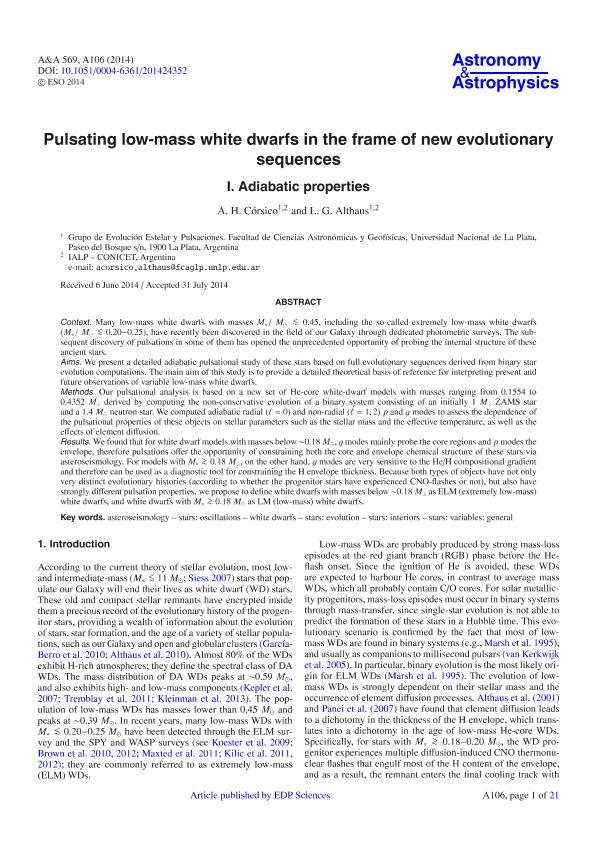Mostrar el registro sencillo del ítem
dc.contributor.author
Corsico, Alejandro Hugo

dc.contributor.author
Althaus, Leandro Gabriel

dc.date.available
2017-04-12T14:54:11Z
dc.date.issued
2014-09
dc.identifier.citation
Corsico, Alejandro Hugo; Althaus, Leandro Gabriel; Pulsating low-mass white dwarfs in the frame of new evolutionary sequences. I: adiabatic properties; Edp Sciences; Astronomy And Astrophysics; 569; 9-2014; 106-127
dc.identifier.issn
0004-6361
dc.identifier.uri
http://hdl.handle.net/11336/15208
dc.description.abstract
Context. Many low-mass white dwarfs with masses M∗/M⊙ ≲ 0.45, including the so-called extremely low-mass white dwarfs (M∗/M⊙ ≲ 0.20 − 0.25), have recently been discovered in the field of our Galaxy through dedicated photometric surveys. The subsequent discovery of pulsations in some of them has opened the unprecedented opportunity of probing the internal structure of these ancient stars.
Aims. We present a detailed adiabatic pulsational study of these stars based on full evolutionary sequences derived from binary star evolution computations. The main aim of this study is to provide a detailed theoretical basis of reference for interpreting present and future observations of variable low-mass white dwarfs.
Methods. Our pulsational analysis is based on a new set of He-core white-dwarf models with masses ranging from 0.1554 to 0.4352 M⊙ derived by computing the non-conservative evolution of a binary system consisting of an initially 1 M⊙ ZAMS star and a 1.4 M⊙ neutron star. We computed adiabatic radial (ℓ = 0) and non-radial (ℓ = 1,2) p and g modes to assess the dependence of the pulsational properties of these objects on stellar parameters such as the stellar mass and the effective temperature, as well as the effects of element diffusion.
Results. We found that for white dwarf models with masses below ~ 0.18 M⊙, g modes mainly probe the core regions and p modes the envelope, therefore pulsations offer the opportunity of constraining both the core and envelope chemical structure of these stars via asteroseismology. For models with M∗ ≳ 0.18 M⊙, on the other hand, g modes are very sensitive to the He/H compositional gradient and therefore can be used as a diagnostic tool for constraining the H envelope thickness. Because both types of objects have not only very distinct evolutionary histories (according to whether the progenitor stars have experienced CNO-flashes or not), but also have strongly different pulsation properties, we propose to define white dwarfs with masses below ~ 0.18 M⊙ as ELM (extremely low-mass) white dwarfs, and white dwarfs with M∗ ≳ 0.18 M⊙ as LM (low-mass) white dwarfs.
dc.format
application/pdf
dc.language.iso
eng
dc.publisher
Edp Sciences

dc.rights
info:eu-repo/semantics/openAccess
dc.rights.uri
https://creativecommons.org/licenses/by-nc-sa/2.5/ar/
dc.subject
Asteroseismology
dc.subject
Oscillations of Stars
dc.subject
White Dwarfs
dc.subject
Evolution of Stars
dc.subject
Interior Stars
dc.subject
Variable Stars
dc.subject.classification
Astronomía

dc.subject.classification
Ciencias Físicas

dc.subject.classification
CIENCIAS NATURALES Y EXACTAS

dc.title
Pulsating low-mass white dwarfs in the frame of new evolutionary sequences. I: adiabatic properties
dc.type
info:eu-repo/semantics/article
dc.type
info:ar-repo/semantics/artículo
dc.type
info:eu-repo/semantics/publishedVersion
dc.date.updated
2017-03-27T15:55:31Z
dc.journal.volume
569
dc.journal.pagination
106-127
dc.journal.pais
Francia

dc.journal.ciudad
Paris
dc.description.fil
Fil: Corsico, Alejandro Hugo. Consejo Nacional de Investigaciones Científicas y Técnicas. Centro Científico Tecnológico La Plata. Instituto de Astrofísica de La Plata; Argentina; Argentina. Universidad Nacional de la Plata. Facultad de Ciencias Astronómicas y Geofísicas; Argentina
dc.description.fil
Fil: Althaus, Leandro Gabriel. Consejo Nacional de Investigaciones Científicas y Técnicas. Centro Científico Tecnológico La Plata. Instituto de Astrofísica de La Plata; Argentina; Argentina. Universidad Nacional de la Plata. Facultad de Ciencias Astronómicas y Geofísicas; Argentina
dc.journal.title
Astronomy And Astrophysics

dc.relation.alternativeid
info:eu-repo/semantics/altIdentifier/doi/http://dx.doi.org/10.1051/0004-6361/201424352
dc.relation.alternativeid
info:eu-repo/semantics/altIdentifier/url/http://www.aanda.org/articles/aa/abs/2014/09/aa24352-14/aa24352-14.html
Archivos asociados
